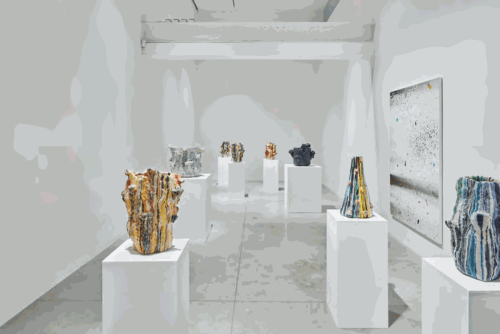The pandemic-induced restrictions of the past year have forced a prolonged intellectual and creative hibernation for many makers. For others, though, the chain of undifferentiated months has been liberating rather than debilitating, freeing them to expand beyond entrenched borders of work and thought. Ceramic sculptor Tony Marsh belongs to the latter category, and his new tabletop vessels presented at albertz benda (installed in a two-person show with the process-driven paintings of Thomas Fougeirol) demonstrate vividly what, for him, lockdown seems to have unlocked. In his nascent series, Spill and Catch (all works 2020), Marsh relaxes his grip on order and symmetry, suspending his glazed surfaces in liquid looseness and indulging in uncharacteristically luscious, exuberant color.
Marsh is no stranger to chance and improvisation, but these new works diverge, and by including representative pieces from two other established, ongoing series, the show made it clear just what they diverge from. His Crucibles (all 2020) adhere to a single, basic template: weighty, straight-sided cylinders barnacled with globular chunks of clay, glazed and reglazed, baked and re-baked, to a crusty finish. Each work in this decade-long investigation fuses the metaphorical and literal meanings of its title; each pocked and cratered vessel has repeatedly endured the trial of extreme heat. The molten gold-and-orange surface of one Crucible appears to still exude heat. The others suggest magma cooled to a crisp charcoal black. Marsh uses similar straight-sided forms for his Moonjars (two from 2018 and one from 2020), but the protrusions take the form of small, more regularly spaced shelves that line the outside wall of two of the pots, and the interior of the third. Each small platform supports a mineral or mineral-like specimen—stone, crystal, frosted glass, a craggy or faceted hunk of clay. Far from the simple poetry of their traditional Korean namesakes—white porcelain spheres embodying purity and luminosity—these Moonjars manifest a compulsion toward accretion and collection. Each proffers material evidence toward a sort of imagined archive, a tabletop cabinet of geological curiosities, an ingathering of marvels.
Fougeirol’s paintings on wood panels (all 2019) resonate with the rugged topographies of earth and moon invoked by Marsh’s vessels, though to a less memorable effect. His methods, too, marry the deliberate and indeterminate. He mixes debris into oil to complicate his painted and scraped surfaces, and also welcomes gravity as an interrupting force, manipulating it to yield stripes that sag and waver. Each panel measures a consistent 40 by 30 inches, and given their standardized, medium format they read like specimen slides or samples of contrived phenomena—records as much as representations. Materiality and process drive both artists, providing a loose logic for the pairing, yet Marsh’s work, shown in greater depth and variety, commands more sustained attention.
Marsh’s new sculptures relate less directly to the natural world than those from his long-running Crucible and Moonjar series. The Spill and Catch pieces have glossy coats that feel more a product of the studio—they conjure the ornamental more than the elemental. Here, Marsh breaks his pattern of working with stable, upright forms, instead shaping vessels that slouch, bulge, and flaunt their clumsiness. The walls of the Spill and Catch sculptures are pushed, punched, dented, tabbed, and warty, torn in places to the point of ragged perforation. Their lips are swollen and lopsided. Glazes of persimmon, cherry, teal, violet, sapphire, white, black, lavender, and forest green cascade down the sides of most of them in soupy stripes, marbling but not mixing. The palette and painterly ebullience broadcast cheer; these works don’t have skins but rather festive costumes. It’s not as though Marsh’s earlier work was short of sensuality, but its seductive materiality happened within more controlled parameters. These feel uncommonly disinhibited, like wet sloppy kisses to imperfection, and to possibility itself.
A few of the Spill and Catch works seem transitional, hybrids of restraint and permission. One, a tall, slim cylinder in quiet tones of umber and ash, sprouts growths up and down its exterior, small round ledges glazed vivid aqua. It’s an entrancing sculpture, suggesting at once a sheath of lichen, a distant waterfall, and a congregation of open-mouthed organisms. The messier, brighter pieces in the new series are less viscerally stirring, but their marriage of the lavish and homely yields a good deal of charm. Their buoyancy serves as a useful foil, or maybe even an act of resistance, to the grimness of 2020. The year required so much paring down and contraction, so much forced interiority. Marsh’s response: defiantly playful, performative works—vessels that spill over. In a time of deprivation, he has been conducting experiments in unabashed excess. The preliminary results testify to a heartening tenacity not just to survive, but to thrive.
Leah Ollman has written features and criticism for the Los Angeles Times since 1987, and has served as Corresponding Editor for Art in America since 1997. Her essays have appeared in books and exhibition catalogs on Alison Rossiter, Michael Light, Michal Chelbin, William Kentridge, and numerous others. She is currently at work on a book exploring the intersection of poetry and photography.

